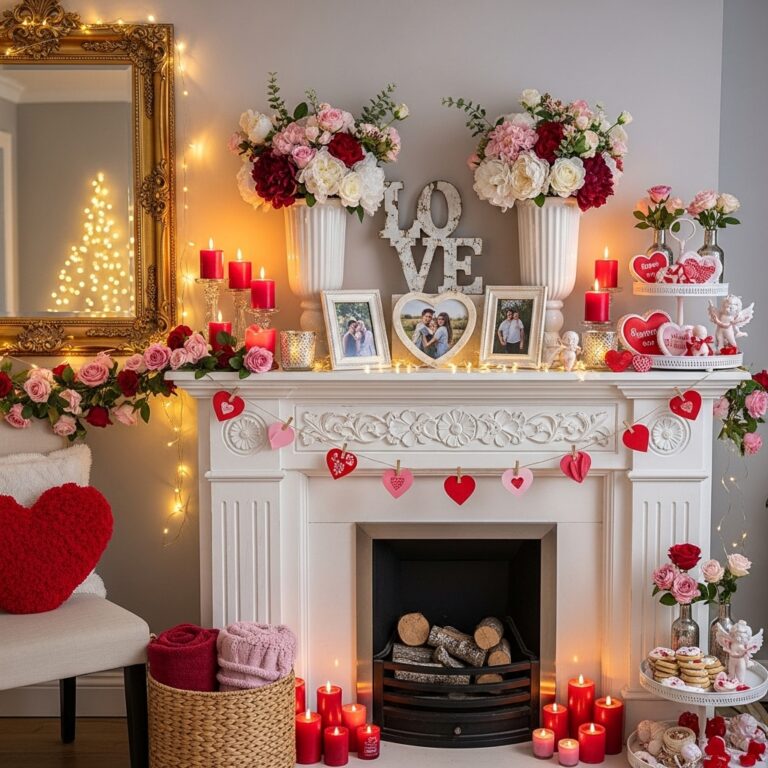12 Small Closet Ideas: Maximize Storage in Minimal Space
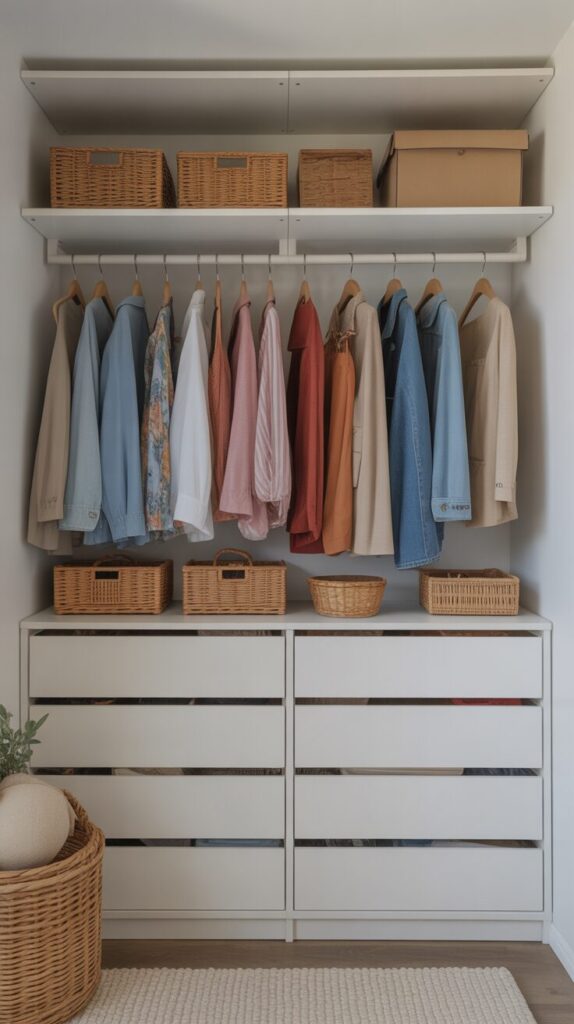
A small closet doesn’t have to mean limited storage or compromised organization—with smart design strategies and creative solutions, even the tiniest closet can accommodate surprising amounts while keeping everything accessible and beautifully arranged. The key to small closet success lies in maximizing every cubic inch through vertical thinking, multi-functional accessories, and ruthless editing of what truly deserves precious storage space. Strategic organization transforms cramped, chaotic closets into streamlined systems where finding what you need takes seconds rather than frustrating minutes of digging through piles. From innovative hanging solutions to clever space-dividing techniques, these approaches prove that thoughtful planning beats square footage every time. Discover twelve inspiring ideas that will help you revolutionize your small closet, creating organized storage that makes getting dressed easier, protects your belongings, and brings calm to your daily routine.
1. Double-Hang Rod System for Maximum Vertical Use
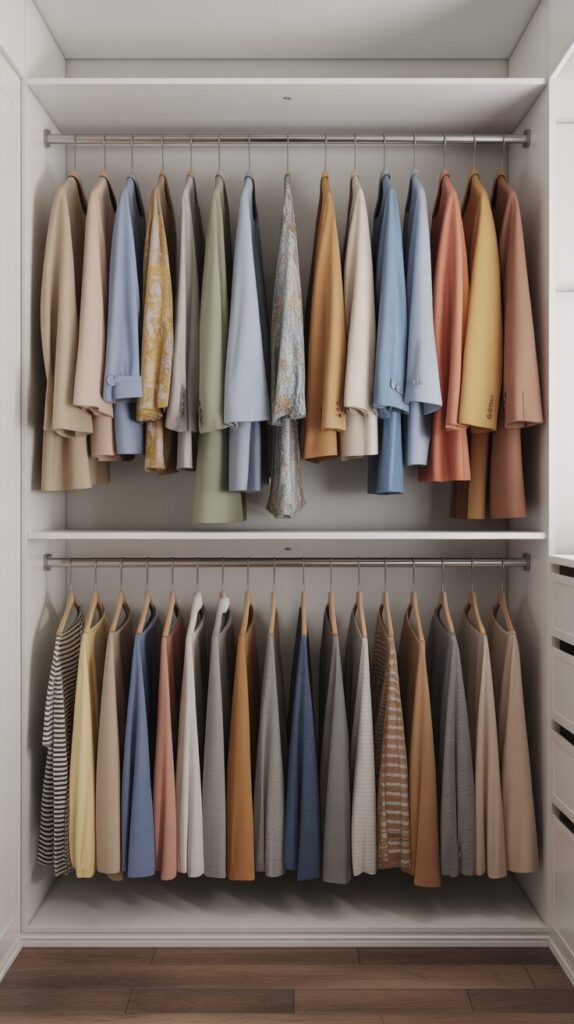
Install two hanging rods at different heights to immediately double your hanging capacity without expanding the closet’s footprint or requiring major renovations. Position the upper rod 80-84 inches from the floor for full-length items like dresses and coats, then add a lower rod 40-42 inches high for shorter garments like shirts, folded pants, and skirts. This configuration works exceptionally well in closets with high ceilings where single-rod systems waste valuable vertical space that could accommodate additional storage layers. Use the upper rod for out-of-season items or special-occasion pieces accessed less frequently, keeping everyday essentials on the lower, more accessible rod for convenient daily selection. Add slim velvet or felt hangers that prevent slipping while occupying less space than bulky plastic or wire options, further maximizing your hanging capacity within the double-rod system.
2. Modular Closet Organization Systems
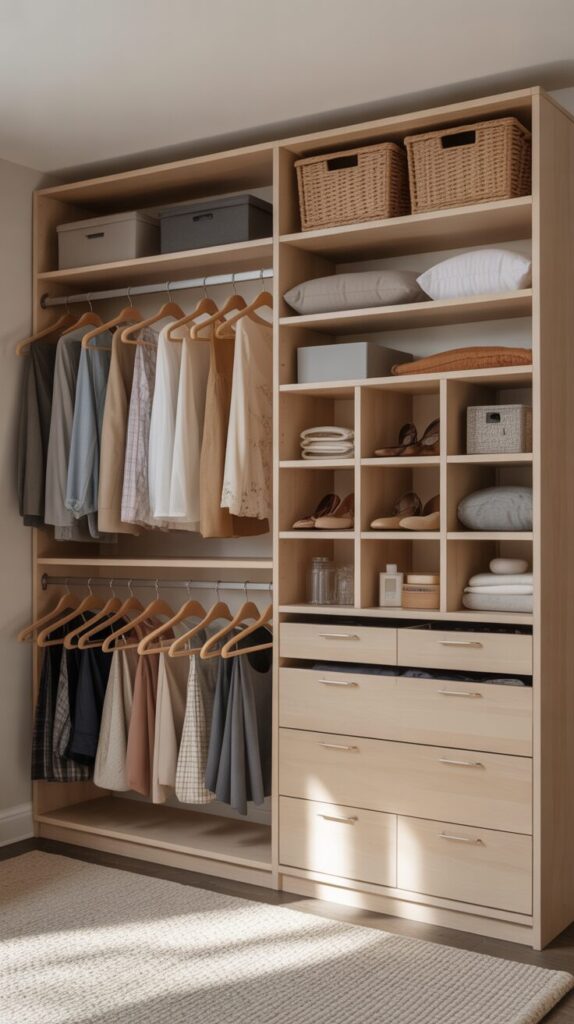
Transform your closet with customizable modular systems offering adjustable shelves, drawers, hanging rods, and accessory organizers that adapt to changing needs and seasons. These versatile solutions install without permanent modifications, making them perfect for renters or those who want flexibility to reconfigure storage as wardrobe needs evolve over time. Mix and match components to create personalized storage zones—hanging space for dresses, cubbies for shoes, drawers for accessories, and shelves for folded items—all within one cohesive system. Choose systems in neutral colors like white or natural wood that blend seamlessly with any décor while maintaining the clean, organized appearance essential in small spaces. The modular approach allows you to start with basic components then expand gradually as budget permits, building your ideal closet system incrementally rather than requiring major upfront investment.
3. Door-Mounted Storage Solutions – Small Closet Ideas
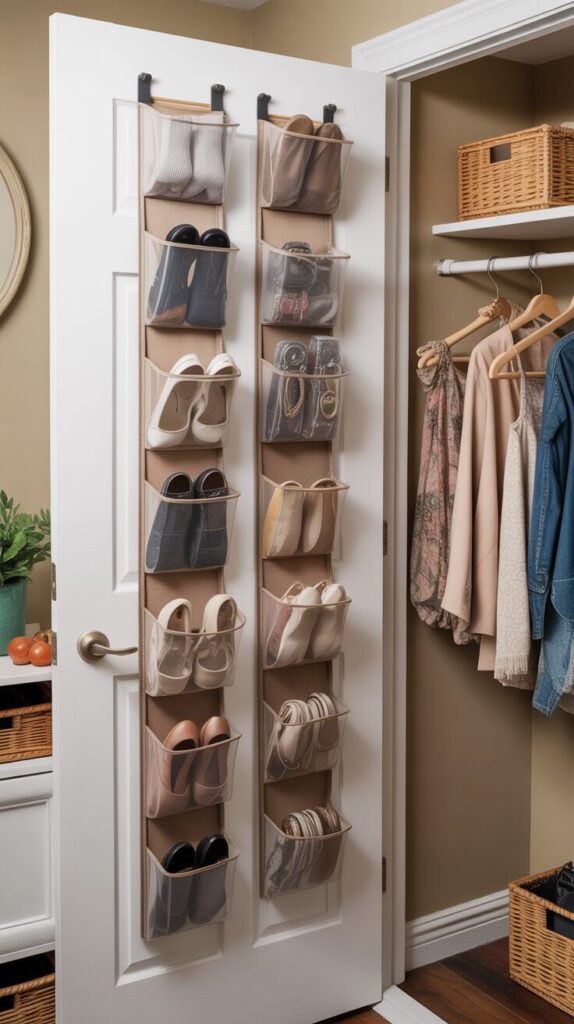
Capitalize on overlooked door space by installing over-the-door organizers, hooks, shoe racks, or jewelry holders that provide abundant storage without consuming interior closet real estate. Choose slim, purpose-built organizers rather than bulky alternatives that prevent doors from closing properly or interfere with items hanging immediately inside the closet. Use the door for frequently accessed items like shoes, bags, scarves, or jewelry that benefit from visibility and easy grabbing as you prepare for your day. Install multiple small hooks at varying heights rather than single large racks to customize storage for different item types and create more flexible organizational possibilities. Consider clear pocket organizers that let you see contents at a glance, eliminating the frustrating search through opaque storage that wastes precious morning minutes when you’re rushing.
4. Vertical Shelf Dividers and Organizers
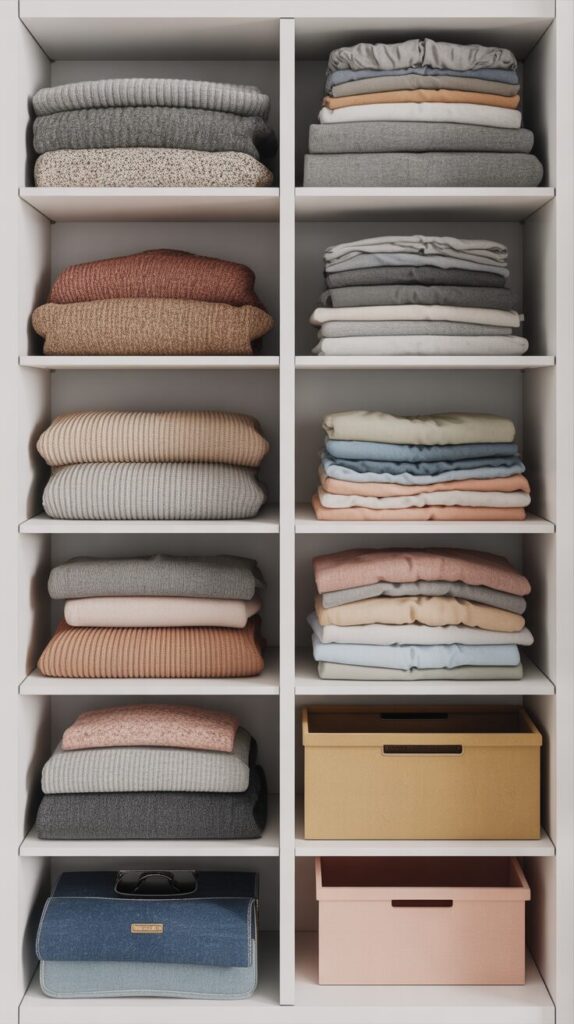
Prevent stacked items from toppling into messy piles by installing shelf dividers that create defined compartments for sweaters, handbags, shoe boxes, and folded clothing. These simple additions transform shelves into organized zones where everything stays neatly separated and easily accessible without disturbing adjacent stacks when removing items. Choose adjustable dividers that accommodate items of varying widths, allowing you to customize compartment sizes based on what you’re actually storing rather than fighting predetermined dimensions. Use vertical dividers to store items on their sides—like clutches, small handbags, or even folded jeans—creating file-system organization that lets you see everything instantly without unstacking. This approach works particularly well for maintaining organization over time since each item has a specific location, making it easier to return things properly rather than tossing them wherever they fit.
5. Under-Shelf Hanging Baskets and Organizers
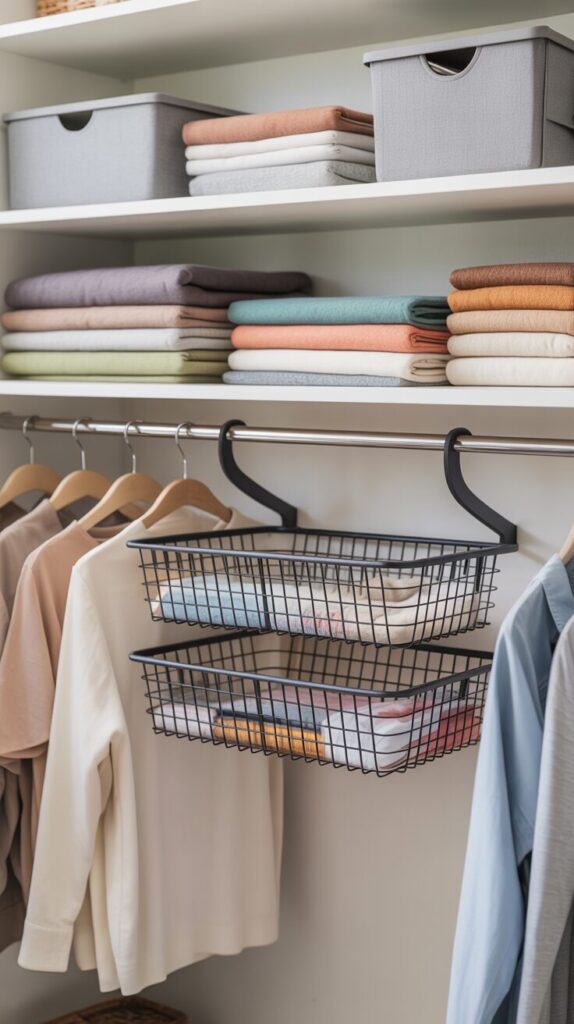
Add instant storage capacity by attaching hanging baskets, racks, or additional shelves beneath existing shelves, utilizing the empty space typically wasted in standard closet configurations. These clip-on or slide-in accessories install without tools or permanent modifications, providing immediate extra storage for accessories, undergarments, socks, or small folded items that fit the shallow depth. Use wire baskets that allow visibility of contents and prevent dust accumulation compared to solid baskets that require pulling out to see what’s inside. Position these organizers strategically beneath shelves storing less-frequently accessed items so you’re not constantly reaching past hanging organizers to grab things from the shelf above. This layered storage approach maximizes cubic footage by stacking storage vertically within the same footprint, dramatically increasing capacity in space-constrained closets where every inch matters significantly.
6. Specialized Accessory Storage Solutions
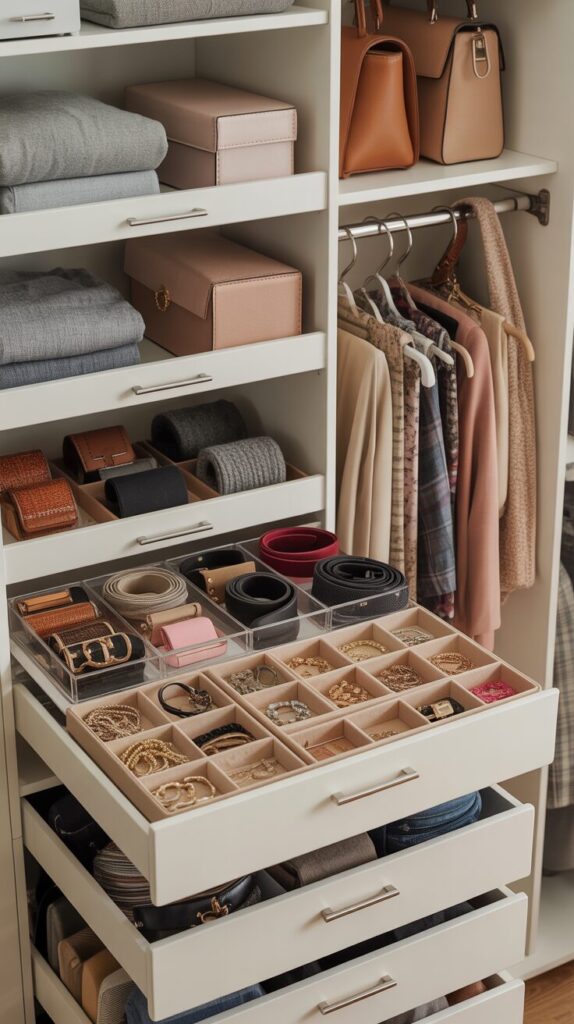
Dedicate specific organizers to accessories like belts, ties, scarves, jewelry, and handbags rather than mixing them with clothing where they create clutter and become difficult to locate. Install belt and tie racks that display items clearly while occupying minimal space, making selection quick and preventing the tangled mess that develops when these items share drawer space. Use clear acrylic organizers or jewelry trays with compartments that keep pieces separated, preventing tangling and damage while letting you see everything at once without opening multiple boxes. Store handbags upright using shelf dividers or in dust bags hanging from hooks to maintain their shape while protecting from dust and light exposure that damages materials over time. Treating accessories as distinct categories requiring purpose-built storage elevates organization while ensuring these smaller investment pieces receive proper care that extends their lifespan and maintains their appearance.
7. Seasonal Rotation and Off-Site Storage
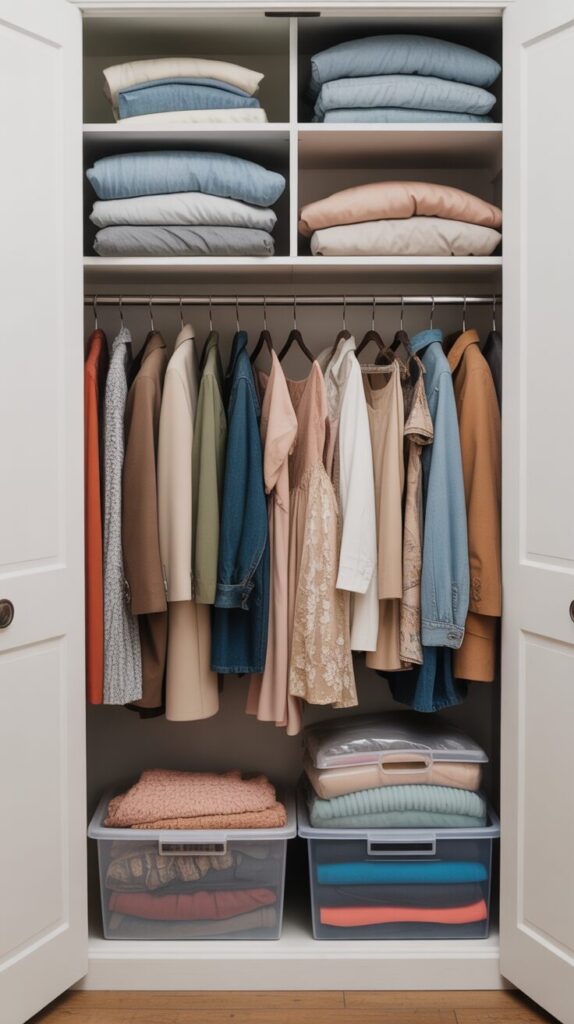
Maintain a streamlined closet by storing out-of-season clothing elsewhere—under beds, in guest room closets, attic spaces, or vacuum-sealed bags—keeping only current season items in your primary closet. This rotation approach effectively doubles your functional closet space since you’re never navigating through winter coats to find summer dresses or vice versa during off-seasons. Use the seasonal swap as an opportunity to evaluate each item: if you didn’t wear it last season, consider donating rather than storing for another year of neglect. Label storage containers clearly with contents and season so retrieving items later requires no guessing or opening multiple boxes to find what you need during seasonal transitions. The twice-yearly rotation ritual forces regular wardrobe assessment, preventing the gradual accumulation that leads to overcrowded closets where nothing is truly accessible or wearable when needed.
8. Slim Specialty Hangers for Space Efficiency
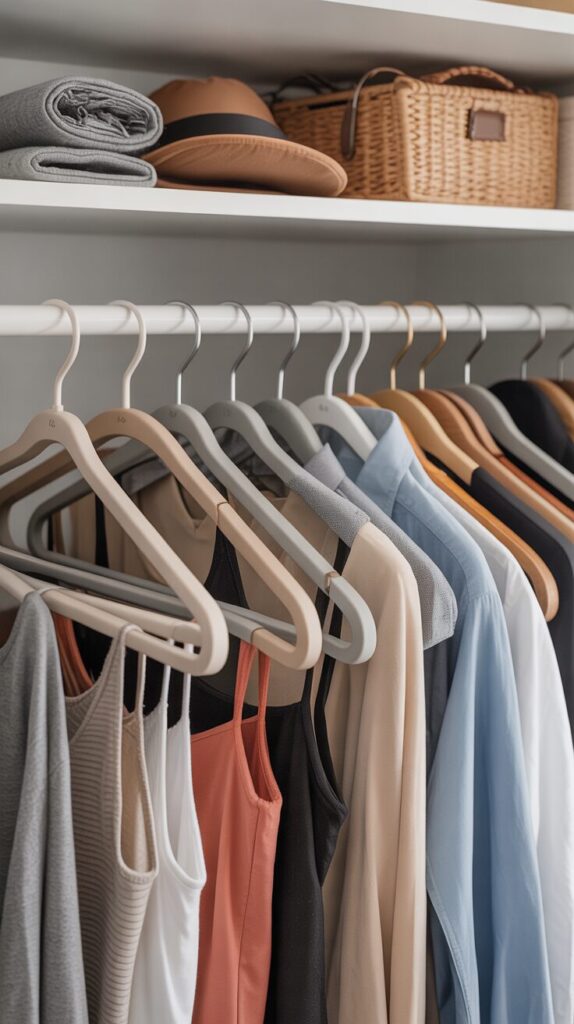
Replace bulky hangers with slim, space-saving versions in velvet, felt, or cascading designs that reduce hanging width while improving garment care and preventing slipping. Quality slim hangers typically occupy one-third to one-half the space of standard plastic hangers, immediately increasing hanging capacity by 50-100% without any other modifications. Use cascading or vertical hangers that stack multiple garments vertically rather than horizontally, perfect for similar items like tank tops, scarves, or multiple pairs of pants. Install hooks or specialty hangers for bags, hats, and belts directly on the closet rod between hanging clothes, utilizing gaps that typically remain empty in standard configurations. The uniform appearance of matching slim hangers creates visual calm and sophistication while the space savings deliver practical benefits that make the investment worthwhile for serious closet optimization.
9. Pull-Out Shelves and Drawers
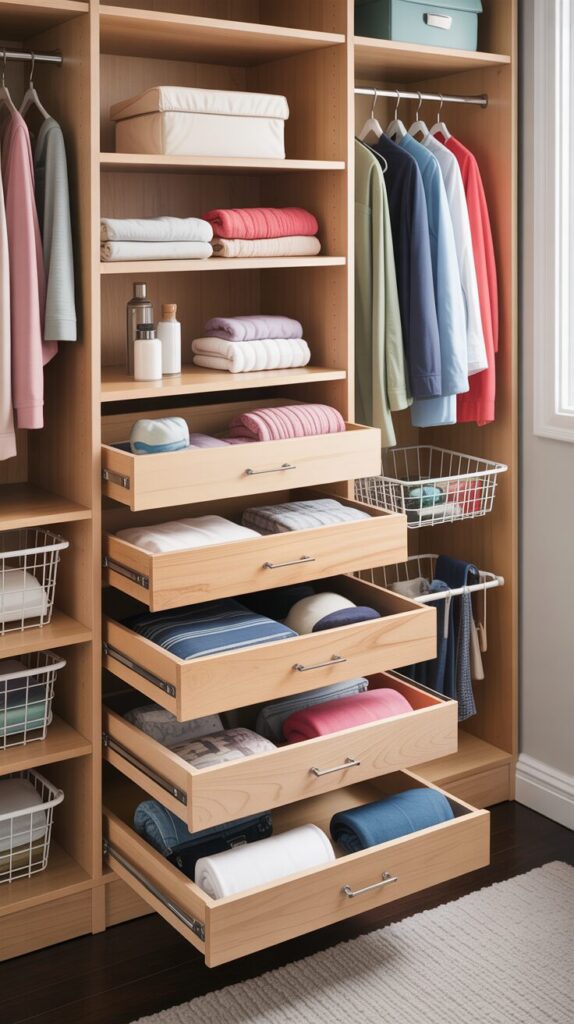
Install sliding shelves or drawer units that bring contents forward for easy viewing and access, eliminating the frustration of items lost in dark closet depths beyond comfortable reach. These mechanisms work especially well in deep closets where back portions become black holes for forgotten items that remain unworn simply because they’re invisible and inaccessible. Use pull-out wire baskets for items like workout clothes, pajamas, or accessories that benefit from ventilation and don’t require the formal presentation of drawers. Position pull-out units at ergonomic heights—waist to shoulder level—for the most comfortable access to frequently used items without excessive bending or reaching. The rolling or sliding action makes these storage solutions particularly valuable for those with mobility limitations who struggle with reaching into stationary deep shelves or crouching to access low storage areas.
10. Color-Coded and Categorized Organization
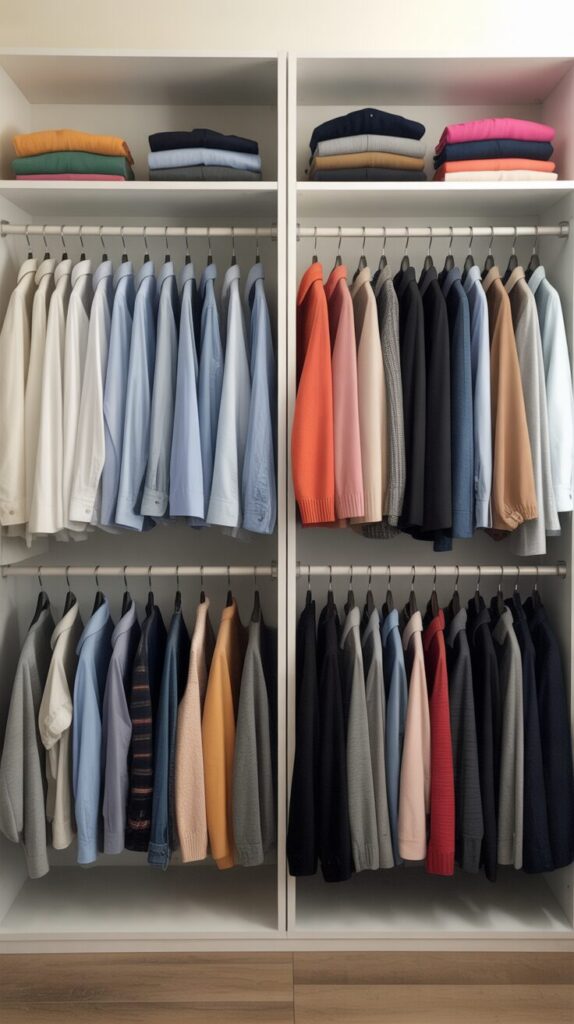
Arrange clothing by category first (shirts, pants, dresses), then organize within categories by color gradient from light to dark for visually pleasing, highly functional organization. This systematic approach transforms closets into boutique-like displays where finding specific items takes seconds since you know exactly where to look based on color and type. Group similar items together—all white shirts in one section, black pants in another—creating mini-collections within your closet that make mixing and matching outfits intuitive and efficient. Use this organization method to identify gaps in your wardrobe (too many black shirts, not enough colored options) and redundancies (five similar navy sweaters) that inform future purchasing decisions. The color-coding creates Instagram-worthy visual appeal while delivering genuine functional benefits that simplify daily dressing and maintain organization over time since items have obvious, logical homes.
11. Lighting Upgrades for Visibility and Ambiance
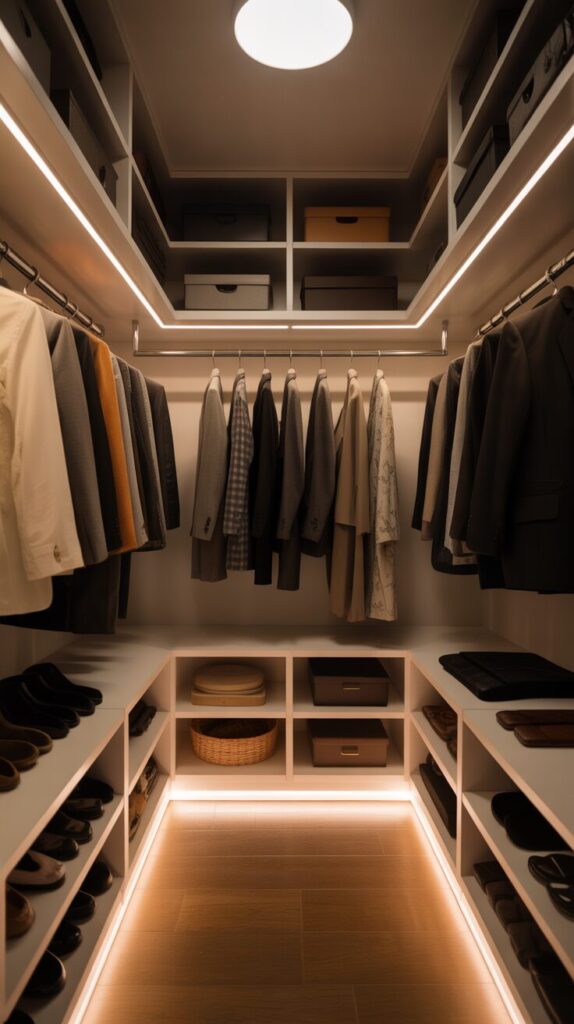
Install LED strip lights, battery-operated puck lights, or motion-sensor lighting that illuminates closet interiors, making it easy to see clothing colors accurately and locate items quickly. Good lighting proves especially critical in small closets without windows where inadequate illumination makes dark colors indistinguishable and contributes to morning frustration when selecting outfits. Position lights to eliminate shadows—under shelves, along the sides, or across the top—ensuring even distribution throughout the closet rather than single-source lighting that leaves corners dark. Choose lighting with high color rendering index (CRI) ratings that display colors accurately rather than distorting hues, helping you make better outfit choices and avoid wearing mismatched items. The improved visibility makes your closet feel larger and more luxurious while the practical benefits streamline daily routines, making the modest investment in quality lighting worthwhile for both function and atmosphere.
12. Multi-Purpose Furniture Integration
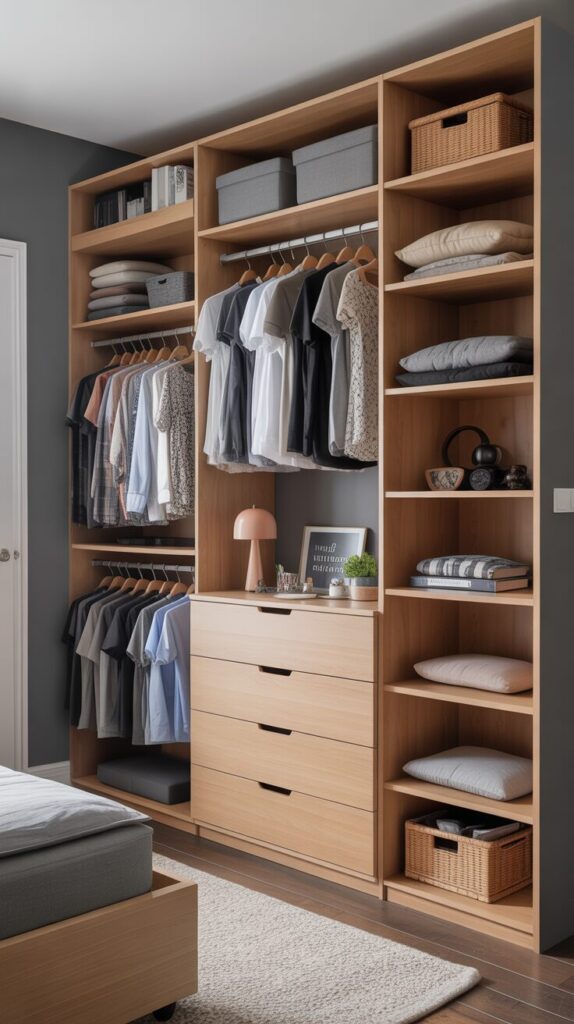
Incorporate furniture pieces like slim dressers, ottomans with storage, or narrow ladder shelves inside walk-in closets or immediately outside reach-in closets to supplement hanging and shelf storage. These pieces provide necessary drawer space for items that fold better than hang—t-shirts, workout clothes, pajamas, undergarments—while adding surface areas for styling accessories or displaying decorative elements. Choose furniture scaled appropriately for your space: narrow tower dressers for tight quarters, modular cube systems for flexibility, or benches with lift-top storage for dual seating and storage functionality. Use the top surfaces of dressers and shelving units to corral daily essentials like watches, sunglasses, and frequently worn accessories in decorative trays that maintain organization while looking intentional. This furniture-forward approach works particularly well in bedroom-closet combinations where the line between spaces blurs, creating cohesive storage solutions that feel like integrated design rather than makeshift additions.
Essential Tips for Small Closet Organization Success
Ruthless Editing and Decluttering: Remove everything from your closet at least twice yearly to honestly assess what you actually wear versus what simply occupies space without contributing to your daily life. Apply the one-year rule: if you haven’t worn it in the past year (accounting for seasonality), donate or sell it to create space for items you’ll genuinely use. Be particularly ruthless with duplicates—keeping five similar black t-shirts when you consistently wear the same two wastes space that could accommodate pieces you’d actually reach for regularly.
Strategic Folding Techniques: Learn space-efficient folding methods like the KonMari vertical fold for drawers that allows you to see all items at once without unstacking, or file-folding for shelves that maximizes capacity. Fold bulky items like jeans and sweaters rather than hanging them since folding typically occupies less vertical space while preventing hanger marks and stretching. Use folding to your advantage in shallow spaces where hanging won’t work but folded stacks or vertically stored items fit perfectly within dimensional constraints.
Regular Maintenance Routines: Establish a “one in, one out” policy where acquiring new clothing means removing an equivalent item to prevent gradual accumulation that inevitably leads to overcrowding. Conduct quick weekly tidying sessions returning items to proper locations, rehoming things that migrated from other rooms, and removing items that need laundering or repair. Schedule seasonal deep cleans when you rotate clothing, using these transitions as natural opportunities for thorough organization and editing rather than letting disorder accumulate unchecked.
Proper Garment Care and Storage: Use appropriate hangers for different garment types—padded hangers for delicate fabrics, clip hangers for skirts and pants, suit hangers for structured pieces—protecting investments while optimizing space. Store special occasion items and delicate fabrics in breathable garment bags that protect from dust and light while preventing the musty smell that develops in sealed plastic. Leave space between hanging items for air circulation that prevents mustiness and allows garments to maintain their shape rather than compressing everything tightly together in ways that cause permanent creasing.
Measurement and Planning: Measure your closet dimensions carefully—width, depth, and height—before purchasing any organizational systems or furniture to ensure proper fit without unpleasant surprises during installation. Account for door swing clearance, drawer pull-out space, and adequate walking room (minimum 24 inches) in walk-in closets when planning storage placement and furniture additions. Create a scaled drawing or use closet planning apps to visualize arrangements before committing to purchases, preventing costly mistakes and ensuring your organizational system works in reality not just theory.
Investment in Quality Solutions: Prioritize quality organizational products that will withstand daily use over years rather than cheap alternatives that break, sag, or fail quickly, requiring replacement and ultimately costing more. Choose adjustable, modular systems that adapt to changing needs rather than fixed solutions that lock you into specific configurations regardless of wardrobe evolution. Consider professional closet design consultations if your budget allows—the expertise often pays for itself through efficient space use and avoiding trial-and-error with products that don’t ultimately work.
Conclusion
A small closet presents opportunities for creative organization that transforms limited space into highly functional storage through strategic planning and smart solutions. These twelve ideas demonstrate that success in small closet design comes from maximizing vertical space, investing in specialized storage accessories, and maintaining ruthless editing standards that keep only items you genuinely wear and love. The most organized closet means nothing if it contains clothes you never choose, so combine physical organization strategies with honest wardrobe curation for truly effective small-space solutions. Whether you implement simple changes like upgrading hangers and adding door storage or undertake complete closet system overhauls, each improvement brings you closer to the streamlined, stress-free morning routine you deserve. Start with the solutions that address your biggest frustrations—inadequate hanging space, lost accessories, poor visibility—then build upon these foundations to create the perfectly organized small closet you’ve been dreaming about all along.
Frequently Asked Questions
How do I maximize a closet with only one rod? Add a second rod below the existing one for shorter garments, use vertical space with stacking shelf organizers, install door storage for shoes and accessories, and utilize the floor with rolling drawers or shoe racks. Under-shelf hanging baskets and over-rod hooks also add capacity without requiring installation or modifications.
What’s the best way to organize a closet with no shelves? Install temporary shelving units that stand on the closet floor, use hanging organizers with multiple shelves that suspend from the closet rod, or add freestanding furniture like narrow dressers or cube storage. Over-door organizers and hooks maximize wall space when shelving isn’t available or installable.
Should I fold or hang clothes in a small closet? Hang items that wrinkle easily (dress shirts, blouses, dresses, suits), hold their shape better hanging (coats, structured pieces), or benefit from visibility for easy selection. Fold bulky knits, heavy sweaters, t-shirts, jeans, and workout clothes that don’t crease easily and occupy less space folded than hanging.
How can I prevent closet clutter from returning? Establish specific homes for every item type, implement a one-in-one-out acquisition policy, conduct weekly quick-tidy sessions, and perform seasonal deep-cleans during wardrobe rotations. The key is maintaining systems consistently rather than organizing once then gradually reverting to chaos through neglect.
What are the best storage solutions for a reach-in closet? Maximize vertical space with double rods, add door-mounted storage for shoes and accessories, use shelf dividers to maintain stack organization, install under-shelf baskets for extra capacity, and ensure good lighting for visibility. Consider a modular closet system designed specifically for reach-in dimensions if budget allows for comprehensive organization.






